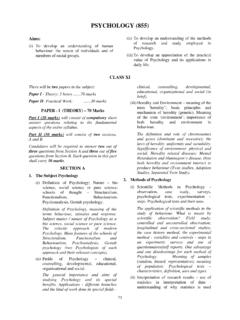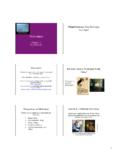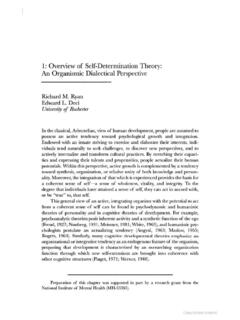Transcription of Motivating Operations: An Introduction Motivation and ...
1 1 A special Thank you to Zachary Ikkanda, a graduate student in one of Dr. Mac s classes. He is also a board certified in ABA. His paper explains Motivation from an ABA viewpoint. Motivating Operations: An Introduction Motivation and Psychology Motivation is an important variable to consider when evaluating the function of behavior. As educators, understanding what motivates children to engage in certain behaviors (or not), allows us to better arrange educational environments and opportunities to encourage the development of new skills. Psychology offers many theories regarding Motivation . Freud introduced the concept of the ID as a person s instinctual drives; the first component of the personality to evolve (Parke & Gauvain, 2009). According to Freud the ID works on the pleasure principle or the notion that the ID wants whatever feels good at the time ( Psychology 101: Chapter 3, 2004).
2 Freud furthers this concept with his theory of Eros, a life instinct, and a death drive, commonly called Thanatos. (Kazlev, 2004) According to Freud, these two basic drives influence every Motivation human beings experience. ( Psychology 101: Chapter 4, 2004). Jean Piaget s constructionist view proposes that children are active in their search for knowledge, a viewpoint that rejects the behaviorism theory that children wait for information (or stimuli) from their environments (Parke & Gauvain, 2009). Albert bandura s work on self-efficacy supposes that most human Motivation is cognitively generated and that people seek self-satisfaction from fulfilling valued goals and are prompted to intensify their efforts by discontent with substandard performances ( bandura , 2004). The concept of Motivation , proposed by many psychologists, assumes that Motivation is an internal state or condition (sometimes described as a need, desire, or want) that serves to activate or energize behavior and give it direction ( Motivation to Learn, 2001).
3 Most traditional psychological theories on 2 Motivation do not examine the role of environmental conditions and their impact on behavior. Applied Behavior Analysis Applied behavior analysis (ABA) is a field of psychology that attempts to identify functional relationships between the environment and a particular behavior in order to determine why people engage in particular behaviors (Miltenberger, 2003). ABA differs from many other branches of psychology in that it does not seek to explain behavior by making reference to mental events or to internal psychological processes ( Behaviorism, 2007). Rather, ABA focuses on sources of behavior [that] are external (in the environment), not internal (in the mind) ( Behaviorism, 2007) ABA utilizes a set of basic principles to analyze and explain human behaviors. Of these principles, the concept of reinforcement is perhaps the most important in explaining increases in the rate behavior.
4 Reinforcement is a process that strengthens a behavior and can be either positive or negative in nature. A positive reinforcer is an event that, when presented immediately following a behavior, causes the behavior to increase in frequency (Martin & Pear, 2003). Negative reinforcement occurs when a behavior results in the removal of an event or stimulus and, consequently, increases the frequency of that behavior in the future (Pierce & Epling, 1999). ABA attempts to explain the causality of behavior through a three-term contingency developed by skinner ( skinner , 1953): Three-term contingency: SD R SR SD : discriminative stimulus R : response SR : reinforcing stimulus In this contingency, a discriminative stimulus (sometimes referred to as an antecedent) is defined as an event or stimulus that set the occasion for behavior, a response is the behavior itself, and the reinforcing stimulus is the event or stimulus that follows the behavior and increases the likelihood of the behavior occurring again in the presence of the SD (Pierce & Epling, 1999).
5 A 3 practical example of this contingency: A teacher presents a difficult in-class assignment to a student and the student screams. The teacher presumes that the student is frustrated and tells him he can take a break. In this example, the assignment (SD) occasions the student s behavior of screaming (R). The removal of the assignment and the break from work function as reinforcers for the behavior of screaming when a difficult assignment is presented (SR). Applied Behavior Analysis and Motivation Many behavior analysts have proposed a 4th term to the traditional three-term contingency, citing the importance of Motivation in analyzing human behavior. Behavior analysts believe that Motivation is influenced by observable, environmental conditions, rather than internal causal theories proposed by psychologists such as Freud and Piaget. skinner , in his, 1938 book The Behavior of Organisms devotes two chapters to Drive and Drive and Conditions (Sundberg & Michael, 2001).
6 In this work, skinner argued against the concept of a drive, proposing the analysis of relationships between environmental events and the behavior they produce, rather than using internal causal variables to explain behavior (Sundberg & Michael, 2001). Additionally, skinner theorized that conditions of deprivation and satiation ( , being thirsty or full) had an evocative effect on behavior (Sundberg and Michael, 2001). In 1941, Keller and Schoenfeld published Principles of Psychology, in which they expanded skinner s theories on Motivation , continuing to explore the interrelationship between deprivation, aversive stimulation, satiation, and response strength. Keller and Schoenfeld, first used the term establishing operations, noting that the term was more precise than the term drive in part, because they theorized that conditions of deprivation, aversive stimulation, and satiation established a drive in humans.
7 (Sundberg, and Michael, 2001). The behavior analytic community embraced this term because it implied environmental conditions, not internal events, increase the occurrence of certain behaviors. 4 Jack Michael revised the theory of establishing operations in a series of papers (Michael, 1982a, 1982b, 1993, 2000). Michael proposed using the term establishing operation (EO) for any environmental variable that: 1) alters the current reinforcing effectiveness of a stimulus, object, or event (establish includes the effect in the opposite direction, abolish) or, 2) alters the frequency of behavior that has been reinforced by the same stimulus, object, or event (and evoke includes an effect in the opposite direction, abate) (Pierce & Epling, 1999). Later, Michael proposed a larger term, Motivating operations, (MO s) to describe both the establishing operations (EO s) and abolishing operations (AO s) (Sundberg, 2001).
8 To simplify, MO s momentarily increase or decrease both the effectiveness of a stimulus as a reinforcer, and the behaviors that have led to the acquisition of that reinforcer, depending on how deprived or satiated an individual is of that reinforcer. Today, many ABA practitioners consider MO s to be antecedent stimuli that evoke behavior: Four-term contingency: MO/SD R SR Types of Motivating Operations There are two main MO s that are important to consider when analyzing the effectiveness of a reinforcer. Deprivation is the most common establishing operation for primary reinforcement and increases the effectiveness of many reinforcers (Pierce, Epling p. 36). For example, a child who has not received a good grade on an exam for some time may be more likely to engage in behaviors that have produced good grades in the past. This example presupposes that good-grades function as a reinforcer for the child.
9 Being deprived of a good grade establishes a good grade as a reinforcer. Satiation can also serve as an MO during situations in which an individual has contacted a large amount of a reinforcer. For example, a child who has just engaged in a large duration of computer play, may be less likely to engage in behaviors that have lead to computer time in the past. In this scenario, an 5 extended computer session temporarily abolishes the effectiveness of the computer as a reinforcer. Unconditioned Motivating Operations & Conditioned Motivating Operations MO s can be unconditioned (UMO s) and conditioned (CMO). Unconditioned MO s are unlearned; for example, humans are born with the propensity to be more reinforced by food when we are hungry than when we are full. In other words, food deprivation (MO) increases the reinforcing effectiveness of food, without learning. Other UMO s include: Being too warm: increases reinforcing value of cooling off Being too cold: increases reinforcing value of warming up Water deprivation: increases reinforcing value of water Oxygen deprivation: increases reinforcing value of oxygen Sleep deprivation: increases reinforcing value of sleep UMO s can also have an abolishing affects as the individual becomes satiated: Becoming warm: abolishes warmth as a reinforcer Becoming cold: abolishes cooling off as a reinforcer Drinking Water: abolishes water as a reinforcer Breathing: abolishes oxygen as a reinforcer Sleeping: abolishes sleep as a reinforcer Conditioned Motivating operations (CMO s) are learned.
10 For example, a child is presented with a number puzzle missing all of the number 4 s (CMO). This increases the reinforcing value of obtaining the number 4. The child responds by requesting the number 4 from a teacher (R). The teacher presents the child with the number 4 puzzle piece (SR). Receiving the puzzle piece abolishes the number 4 puzzle piece as a reinforcer. In the 4 term contingency: 6 Puzzle (SD)/Missing the Number 4 (MO: Increase Value of 4 Puzzle Piece) Child Requests Number 4 (R) Teacher Presents the Number 4 Piece to Child (SR) Another example: You press play on your portable CD player and it doesn t work (CMO). This increases the reinforcing value of obtaining batteries. You go find batteries and put them in your CD player (R). Your CD player works again (SR). Placing the batteries in your CD player, abolishes batteries as a reinforcer. In the 4 term contingency: CD Player (SD)/Doesn t Work When Play is Pressed (MO: Increases Value of Batteries) Retrieve Batteries and Put Them In CD Player (R) CD Player Works Again (SR) Motivating Operations and The Classroom McGill 1999, notes that the most immediately visible effect of the [MO] is the altered rate of behaviors associated with the relevant reinforcer (McGill, 1999).


